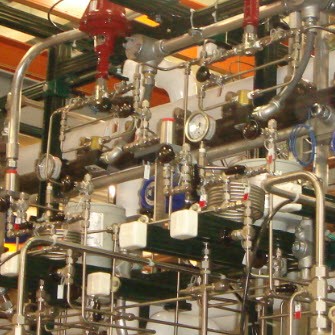
“But it’s More Expensive!”: Tubing or Pipe for Pilot Plants
The question has been debated for years by every new generation of pilot plant designers and operators. Should I use tubing or pipe for my pilot plant. Pipe is cheaper, available in larger sizes, and common throughout the petrochemical, pharmaceutical, and food industries. You think it would be an easy decision. Tubing allows use of compression fittings, is available in smaller and a wider range of sizes, and has numerous advantages for pilot plant service.
· Every joint is a potential disassembly point. This has significant advantages in pilot plant service for modifications, troubleshooting, cleaning, and similar tasks. Some clearance is needed when using standard compression fittings but it’s small and certainly trivial to having to unthread pipe or open a union.
· The tubing can be bent eliminating numerous leak points at elbows. This is a big potential operational savings. Bending also allows configurations impossible to achieve with piping.
· Tubing saves space and space is always a premium on pilot plants. The tubing is smaller. It can be bent in a tight radius and bent to reach difficult spots. Numerous adaptors are available to reduce the number of fittings and hence both the space required and the potential leak points created.
· Tubing with compression fittings are easily leaned, quick to assemble, and require no special tools in the smaller sizes. That means that the pilot plant operators can do many small changes themselves with no outside assistance.
· Compression fittings seal better than threaded pipe fittings and are more resistant (although not impervious) to thermal cycling and vibration. And their lower leak rate is a tremendous advantage to pilot plant work.
Tubing also has some smaller and less obvious advantages over piping including often a higher pressure rating, a lower pressure drop, less dead pockets, and no need for sealants. These are also beneficial although usually not as strongly as the above.
So maybe the question should be restated as why would anyone use pipe on a pilot plant?
First, tubing is limited due to the largest sizes of commercially available compression fittings. Compression fittings for tubing are commonly available in numerous types and configurations up to 1” OD with some limited types available up to 2” OD. Past that size you are pretty much forced to use pipe unless you get some specialty welded fittings. (And welding is always less desirable on pilot plants in general as it is difficult to modify and more costly to install.) Compression fittings also appear more expensive than pipe when the individual parts are compared. The savings get smaller as the total parts list is generated as tubing and compression fittings save by requiring fewer elbows and usually no unions. The analysis reverses when the labor costs are included as tubing installs significantly faster than pipe. This labor savings increases as the experience of the personnel decreases. Compression fittings can be installed properly with minimal training and experience. Laying out a system in tubing is much easier for inexperienced personnel than pipe. (Please note that experienced personnel always do a much better job with both systems. Inexperienced personnel will always be less effective with bot systems. But inexperienced personnel can do an adequate job much better and more often with tubing than pipe.) In my experience, tubing typically saves 25-50% of the cost of pie when both labor and materials are included.
In addition, there are numerous other advantages to using tubing. You can purchase valves with integral compression fittings. This eliminates two potential leak points on every valve which adds up to a significant total savings. You can get significant ancillary equipment with tubing ends such as flow meters, filters, regulators, and pressure gauges.
So, at least in my opinion, tubing is usually the way to go.
For other articles on the use of tubing in pilot plant and laboratory serves see:
· Hydrostatic Testing of Pilot Plant Scale Tubing: Is it Necessary?
o https://www.linkedin.com/pulse/hydrostatic-testing-pilot-plant-scale-tubing-richard-palluzi/
· Locating Leaks in Pilot Plants and Laboratory Units and Equipment
o https://www.linkedin.com/pulse/locating-leaks-pilot-plants-laboratory-units-richard-palluzi/
· Testing For Leaks In Pilot Plants
o https://www.linkedin.com/pulse/testing-leaks-pilot-plants-richard-palluzi/
For training in this area see the University of Wisconsin course on Pilot Plant Equipment 1: Fundamentals for Proper Selection. Go to https://epd.wisc.edu/segment/products-processes/advanced-processes/ and search for the course name.
Retired Sr. M&E Techology Fellow at Dow
4yI agree. Tubing.